This blog article is part of the 20sPeople season – a season of exhibitions, activities and events from The National Archives that explores and shares stories that connect the people of the 2020s with the people of the 1920s.
Highways of Empire
If you found yourself walking on Charing Cross Road on New Year’s Day in 1927, you’d be confronted with an astonishing sight. Pasted to an advertising hoarding 20 feet long and 10 feet high was a huge poster showing a world map under the title ‘Highways of Empire’. This poster was designed by Macdonald Gill for the Empire Marketing Board and its intention was to visualise the British Empire with Great Britain at its physical centre.
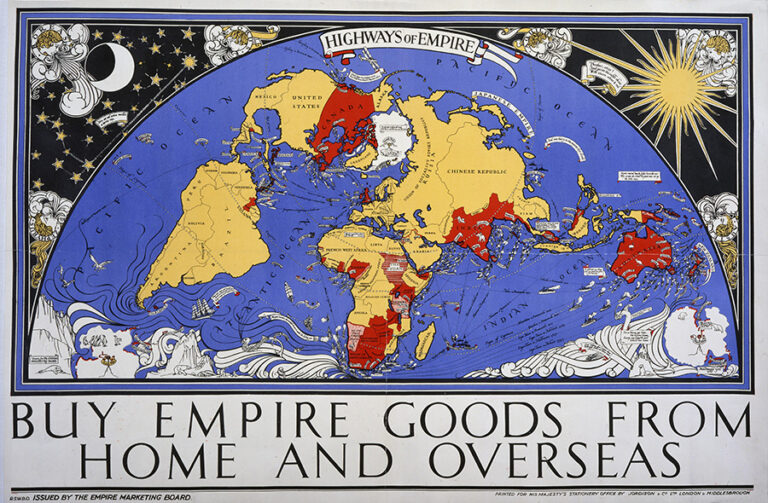
In The Times published that day, the unveiling of the poster was reported:
‘Designed to show at a glance the extent, relations, and connexions of the British Empire, the new poster map issued by the Empire Marketing Board is a great success. It brings geography to life …The lettering throughout is admirable, clear and graceful, and wherever possible without obscuring the map, the artist has introduced characteristic emblems – typical animals and birds of the different continents, fish, and sea monsters – and appropriate quotations.’
‘Highways of Empire’, The Times, 1 January 1927, Issue 44468, page 12, © Times Newspapers Limited
The designer Macdonald Gill was well-known at the time as a talented graphic designer who specialised in maps, most notably his popular ‘Wonderground Map of London Town’ which was first displayed in 1914[ref]Caroline Walker and Andrew Johnston, ‘The life and legacy of MacDonald Gill’, The British Library, (accessed 7 February 2022). ‘Highways of Empire’ was also positively received by the public and smaller prints were displayed and sold all over the country. Stephen Constantine, Buy and Build: The Advertising Posters of the Empire Marketing Board, HMSO (1986), p. 11.[/ref]. One of these posters is on display at The National Archives’ exhibition, The 1920s: Beyond the Roar.
One intriguing detail is the illustration of a polar bear in Antarctica at the bottom of the poster. This was a mistake, only noticed too late in the production process, so the humorous speech bubble was added in asking ‘Why are we here? We belong to the North Pole’, while another sings ‘It’s a long way to Tipperary’![ref]The National Archives, ‘Highways of Empire’, 1926-39, Catalogue ref: CO 956/537.[/ref]
‘Highways of Empire’ was one of the first examples of the work of the Empire Marketing Board, a government department which existed between May 1926 and September 1933. This short-lived but very productive department was set up in response to concerns about Britain’s economic situation and its relationship with its empire.
The British Empire in the 1920s
After the First World War, the British Empire was larger than it had ever been, covering approximately a quarter of the world’s land surface, with over 400 million people living within it. At the same time, the British economy was struggling as a result of the war and rising competition from Germany and the USA. Anti-colonial movements were also developing and to some the Empire was beginning to appear to be unmanageable.
In the face of these developments, many in the British government felt that the Empire was Britain’s economic saviour, and Britain needed to strengthen her trade and relations with colonial countries in order to become self-sufficient and withstand international competition. Leo Amery, Secretary of State for the Colonies from 1924 to 1929, was a fervent supporter of the policy of imperial preference, and was instrumental in setting up the Empire Marketing Board[ref]Stephen Constantine, Buy and Build: The Advertising Posters of the Empire Marketing Board, HMSO (1986), p. 3.[/ref].
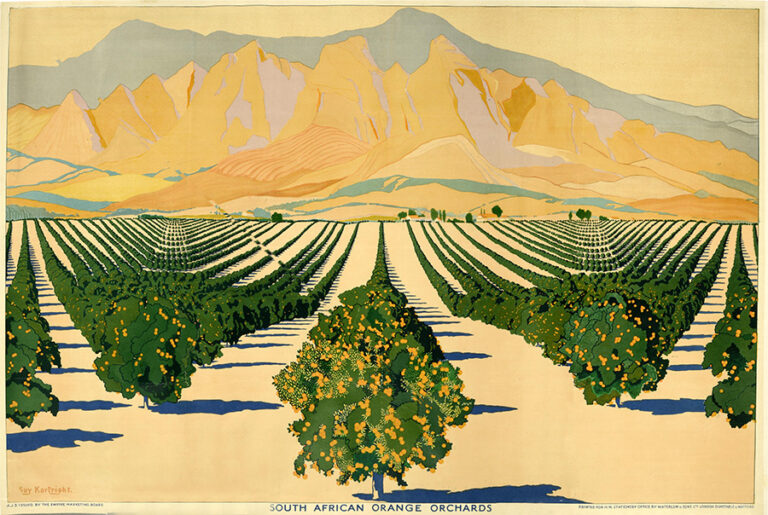
The Empire Marketing Board
One of the key tasks of the Empire Marketing Board was to produce publicity materials to promote the various industries and produce of different countries, and to encourage people in Britain to buy goods from those countries. A first step towards this was producing material to improve people’s knowledge of the empire, which at the time was often limited. Leo Amery in fact complained that many consumers and shopkeepers believed that Californian tinned fruit was an Empire product[ref]Stephen Constantine, Buy and Build: The Advertising Posters of the Empire Marketing Board, HMSO (1986), p. 3.[/ref].
The Board used a multimedia approach to its campaigns, organising Empire Shopping Weeks and communicating via leaflets, films and the radio. But it is the posters produced by the Board that are the most well-known, and this is perhaps because of the great quantity and variety of designs and the modern graphic design approach that was taken.
Graphic design was a growing industry in the 1920s, spurred on by improvements in printing processes, commercial pressure and the development of visual propaganda during the First World War. Between 1920 and 1928, expenditure on advertising in Britain rose from an estimated £31 million to £57 million[ref]Leah Armstrong and Felice McDowell, Fashioning Professionals: Identity and Representation at Work in the Creative Industries, Bloomsbury Publishing (2019), p. 86; Stephen Constantine, Buy and Build: The Advertising Posters of the Empire Marketing Board, HMSO (1986), p. 4.[/ref].
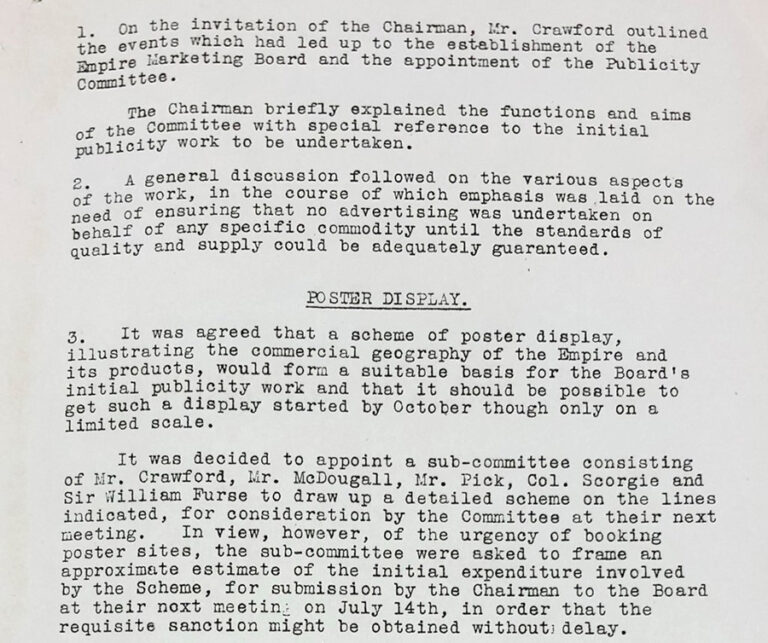
Some key figures in the industry were involved in the work of the Empire Marketing Board. William Crawford, head of a major British advertising agency, was appointed vice-chairman of the Publicity Committee. Frank Pick, best-known for his work at London Underground, was made chairman of the poster sub-committee[ref]The National Archives, ‘Publicity Committee. 1st Sub-Committee. Poster Section. Minutes and Papers’, 8 July 1926. Catalogue ref: CO 760/26; Stephen Constantine, Buy and Build: The Advertising Posters of the Empire Marketing Board, HMSO (1986), p. 4.[/ref]. The Board commissioned designs from a range of experienced artists and designers, many of whom had been involved in commercial design as well as having worked for other government and public organisations.
‘Buy Empire Goods’
Many of the posters were designed to be very direct, telling consumers to ‘buy Empire goods’ or ‘buy New Zealand lamb’. Some depicted an idyllic idea of patriotic shopping. This example, designed by H S Williamson in 1928, shows crowds shopping at John Bull & Sons greengrocer. All of the colourful produce piled outside is labelled with countries of origin and signs announce ‘the Empire is your garden’ and ‘ask for home grown fruit’[ref]The National Archives, ‘Grocer, greengrocer, butcher’, 1926-39, Catalogue ref: CO 956/684.[/ref]. This original poster is on display in The National Archives’ exhibition, The 1920s: Beyond the Roar.
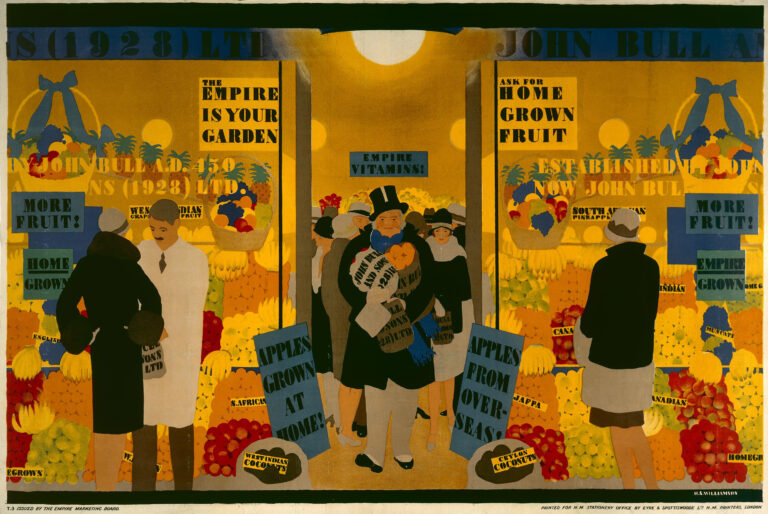
Another famous example of direct publicity is the Empire Christmas Pudding. This campaign focused on showing consumers how they could make a Christmas pudding using ingredients which came from countries of the British Empire. The campaign began with a recipe from the King’s chef Mr Cédard[ref]The National Archives, ‘An Empire Christmas Pudding (Recipe)’, 1926-39, Catalogue ref: CO 956/602.[/ref], and a colourful poster was designed by F C Harrison to promote the campaign showing a woman making the pudding in her kitchen.
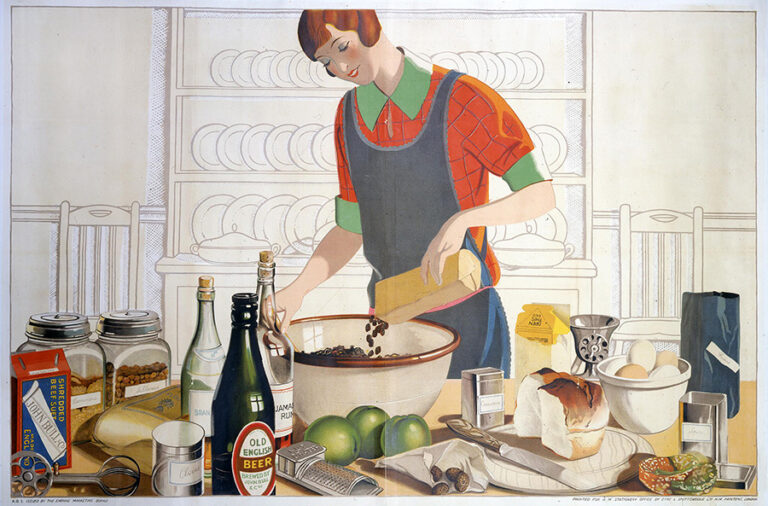

Landscape, industry and people
A key aim of the Empire Marketing Board as it commissioned artwork was to give British people beautiful colourful visions of the landscapes, industries and people of the Empire. This could help people to imagine the Empire in a positive light and, in so doing, encourage people to buy goods from within the Empire. This is no doubt why so much focus was put on producing beautiful images.
Charles Pears was one artist who designed some striking posters for the Board. He was known as a marine artist and worked as an official War Artist during the First World War. He also produced work for London Underground and various railway companies.
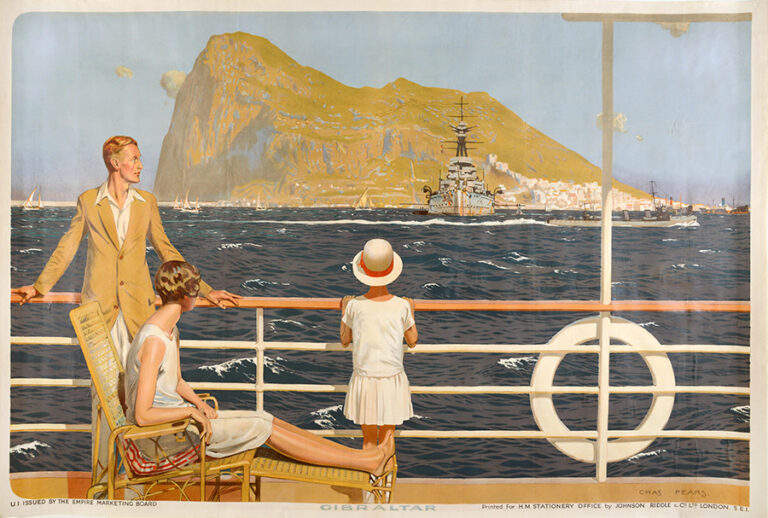
Depicting industry was another important strand for the Board, and Clive Gardiner was one artist who produced some of the most unusual images in this area. As an artist he was interested in Cubism, Futurism and Surrealism and these influences are clear in his poster designs under the title ‘Empire buying makes busy factories’. Gardiner also produced many posters for London Underground[ref]University of Brighton, ‘Clive Gardiner (1891-1960)’, (accessed 7 February 2022).[/ref].
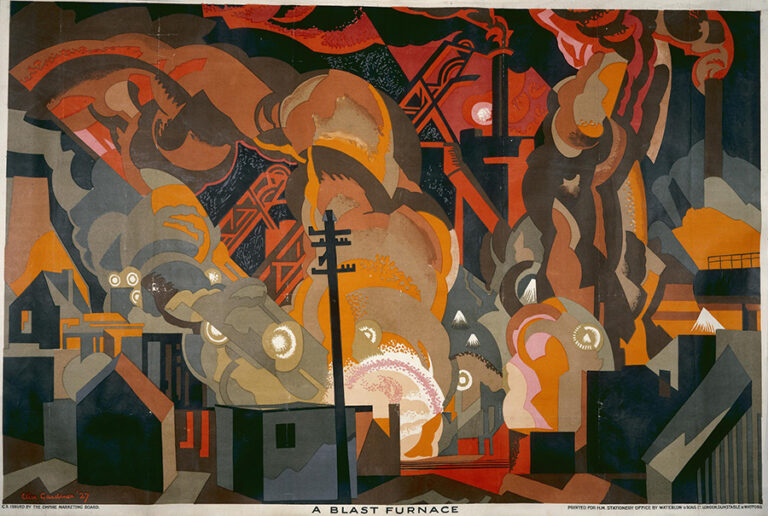
The people depicted in the posters of the Empire Marketing Board reflect colonialist attitudes to race and class. The posters present relations within the Empire in an idealistic and simplistic way and mostly display a hierarchical and unequal societal structure, with non-Europeans as workers and Europeans as rulers[ref]Jules Matthew Maffei, ‘Marketing race in British history: An analysis of The British Empire Marketing Board Posters (1926-1933)’, (2021). Theses and Dissertations. 2904. https://rdw.rowan.edu/etd/2904 pp. 42-3.[/ref]. The complex ideas of race and class communicated by these images may have influenced the way people thought about and depicted the British empire for years afterwards[ref]Jules Matthew Maffei, ‘Marketing race in British history: An analysis of The British Empire Marketing Board Posters (1926-1933)’, (2021). Theses and Dissertations. 2904. https://rdw.rowan.edu/etd/2904 p. 48.[/ref].
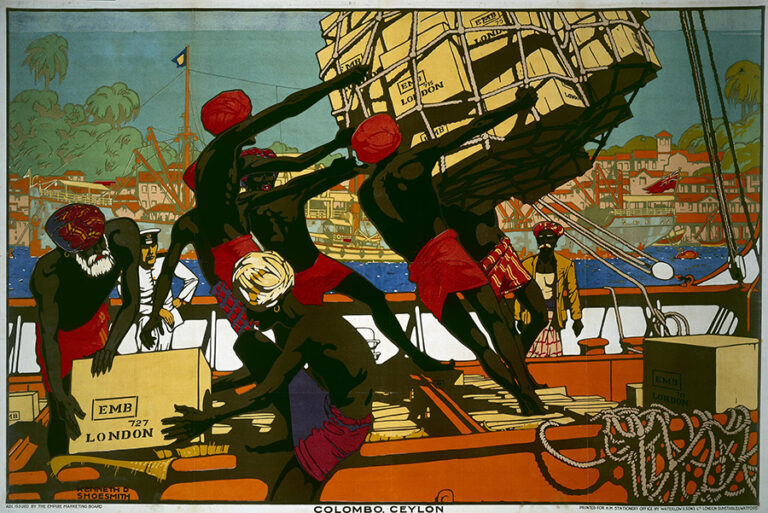
The end of the Empire Marketing Board
While many posters created by the Empire Marketing Board did receive praise on account of their aesthetics and perceived educational value, there was also criticism that they were not sufficiently direct to be useful for their purpose. Perhaps more importantly for the future of the Board, there was also hostility from many who felt that official propaganda was objectionable in principle, and that government should not be telling people what to do. This hostility resulted in a reduction in funding and ultimately the Board was abolished in 1933[ref]Stephen Constantine, Buy and Build: The Advertising Posters of the Empire Marketing Board, HMSO (1986), p. 15.[/ref].
The actual impact of the Empire Marketing Board posters was difficult to estimate even at the time, due to the very broad objectives of the Board and the lack of any systematic method of surveying the population. However, the imagery presented by the posters may well have influenced longer-term conceptions of the British Empire.
The National Archives’ collection
The National Archives holds more than 700 posters of the Empire Marketing Board in record series CO 956, alongside original correspondence, minutes and papers. Some copies of posters are held in other archives, including the Victoria and Albert Museum and Birmingham Polytechnic Library.
20sPeople at The National Archives
20sPeople at The National Archives explores and shares stories that connect the people of the 2020s with the people of the 1920s. Accompanying the release of the 1921 Census of England and Wales, 20sPeople shows what we can learn by connecting with those who have gone before us. Find out more at nationalarchives.gov.uk/20speople.
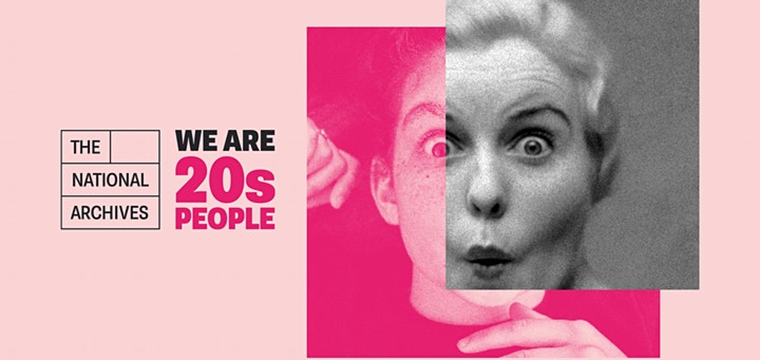
Just to add a little more about Charles Pears.
Serving as a Royal Marines officer during the First World War, he was indeed a gifted marine artist painting in a number of styles and became the first elected president of the Royal Society of Marine Artists.
He was also an official war artist during the Second World War and many of his artworks from both conflicts are in the care of Imperial War Museum.
A number of these can be viewed online at the IWM Collections webpages.
I think one could say with greater confidence that the very large stand alone triptych Empire poster displays on prominent sights in many cities attracted a lot of interest as they were regularly changed and caused widespread comment. Also the sheer volume of EMB posters and other such ephemera circulated in schools in the later 20s and early 30s exerted considerable impact on the wider public. The account provided here is helpful but lacking insight into those aspects of imperial propaganda and material culture that still resurface today. Of course, it is politically difficult to do so in the current climate of cultural debate.